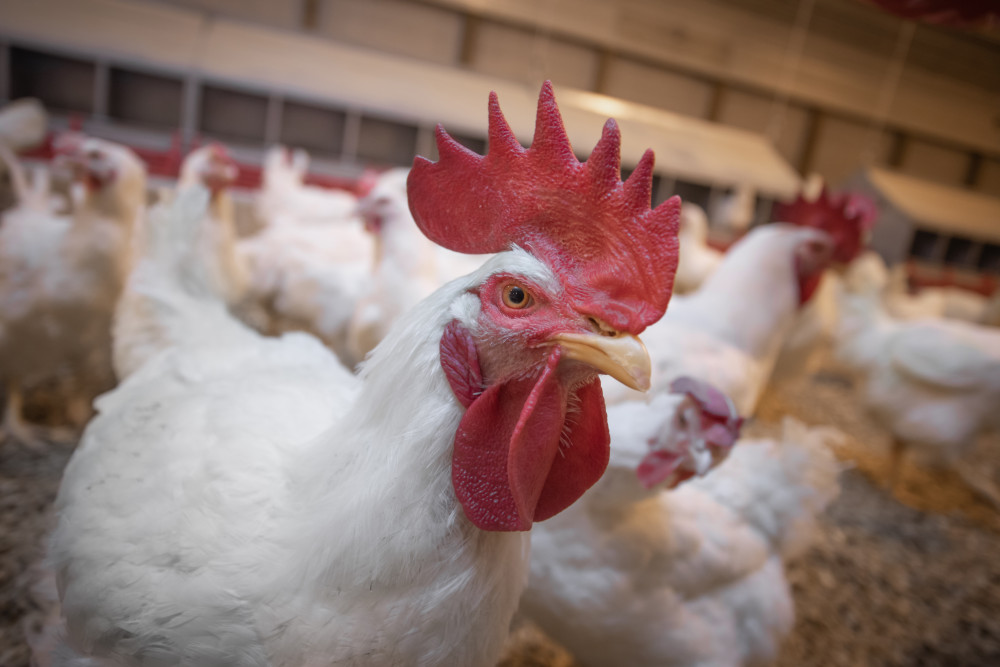Historically, male breeder production in the USA has experienced varying degrees of success when implementing straight-line pan feeders. Even with the simplicity of the management for straight-line pan feeders, company to company and farm to farm performance varies. Males are typically placed on breeder farms at a ratio of 8 to 10 males per 100 females and at a ratio of 7 to 9 males per pan. Male feed is calculated on the farm at weight per hundred males. For example, 900 males fed 25.0 lb (11.3 kg) per 100 would receive 225 lb (102 kg) of feed. If we look at this on a per male basis (1 male) his allotment would be 0.25 lb (0.113 kg). The question is, can we accurately measure and deliver the correct amount of feed to each male day after day? How much feed would we expect to find in each pan? For a male breeder facility with 900 males, we need to have a minimum of 100 pans to achieve the 7 to 9 males per pan target. Considering the 225 lb (102 kg) of feed calculated in the example, we would expect 2.25 lb (1.02 kg) of feed per pan to confirm good feed distribution across the feed system. A good breeder male manager will continuously evaluate all the factors involved in good management. The top 4 factors include: accurate feed weighing, separate sex feeding, correct feeder height, and good feed distribution.
Weighing Feed Accurately
There are a variety of scale systems available to weigh feed. Select the system that will provide the greatest accuracy. Become familiar with all aspects of the scale system.
- As part of the maintenance schedule, all scales must be calibrated at least twice a year.
- Verify scale accuracy weekly by confirming the known weight of an object.
- Visually check scales daily for debris or anything that may interfere with the function of the scale.
- Before every use, make sure the scale starts at zero and returns to zero after every weight is recorded.
- Make sure that the correct weight units (lb verses kg) are being recorded when reading a scale or setting up a digital scale.
- Feed must be accurately weighed. Do not cut corners on this. For example: If feed is weighed +/- 10 lb (4.54 kg) over a one-week period, males could be over or underfed by as much as 70 lb (31.75 kg) of feed.
Separate Sex Feeding
Accurately weighing and distributing a set amount of feed to males and females is critical to control body weight and achieve outstanding flock uniformity and performance. This cannot be achieved if both sexes are eating from the same feeder. If fed from the same feeder males and females may receive the appropriate amount of feed, the total calories consumed by sex will not be correct.
- Separate Sex feeding must be verified by Grower/Caretaker and Service Personnel.
- Female feeders must run before the male feeders to allow females to clear the floor. Male feeders may then run (presentation feeding is preferred). Provide good male restriction on the female feeders.
- Males and females need to be trained to their respective feeder immediately after transfer.
- Male feeders must be used beginning with the first morning after males are moved.
Feeder Height
Male feeder height is critical and probably more critical just after transfer. The male feeder must be at a height that allows the males to eat comfortably but also prevents female access from the male feeder.
- Each morning conduct a visual inspection of the male feeder height from end to end.
- Males should be able to eat from the feeder in a calm, natural matter (no stretching or jumping).
- Pans should be locked with no swinging action.
- Guides/chain can be hung from male feeder for a visual indicator of feeder height when lowered.
Feed Distribution
Feed must be delivered accurately and evenly across the pan system. An uncharged feeder is the preferred method of feeding, as the same amount of feed needs to be delivered to every pan.
- Determine the number of males per pan
- All pans should be set on same setting
- Once males finish the feed in the pans, raise feeder line, weigh feed, and fill pans for the next day (around 12 PM). Check pans daily in the afternoon to ensure feed is distributed evenly in all the pans with no charge in the auger tube. Make the appropriate adjustments in pan settings as feed volume increases.
- There should never be feed left in the hopper to distribute the next morning.
- All feed should be out of the tube and in the pans.
- Make sure that a uniform allocation of feed is in each pan. For the example, the weight of feed per pan should be 2.25 lb (1.02 kg).
Conclusion
Male feeder management is critical to achieve strong fertility and chicks per hen housed. With small margins for error, small deviations from standard recommendations can be detrimental to good flock performance. The best approach to maximize fertility for the life of the flock is to pay attention to details. Good male feeder management will allow better control of male weights and fleshing necessary to achieve top performance.


